Unit 2 Robots grammar 不定式的时态和语态(浙江省杭州市余杭市)
文档属性
| 名称 | Unit 2 Robots grammar 不定式的时态和语态(浙江省杭州市余杭市) | 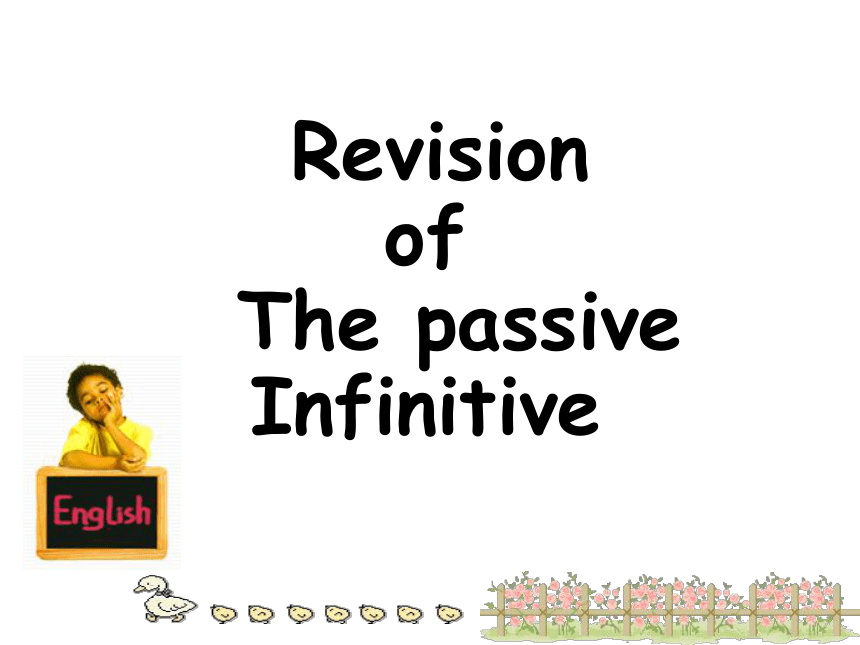 | |
| 格式 | rar | ||
| 文件大小 | 3.0MB | ||
| 资源类型 | 教案 | ||
| 版本资源 | 人教版(新课程标准) | ||
| 科目 | 英语 | ||
| 更新时间 | 2009-05-12 16:32:00 | ||
图片预览

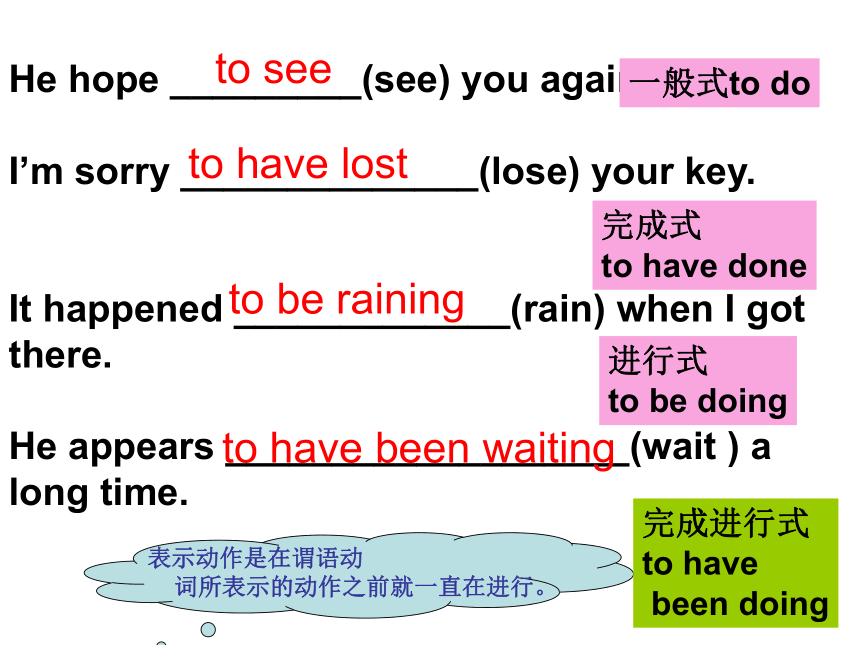
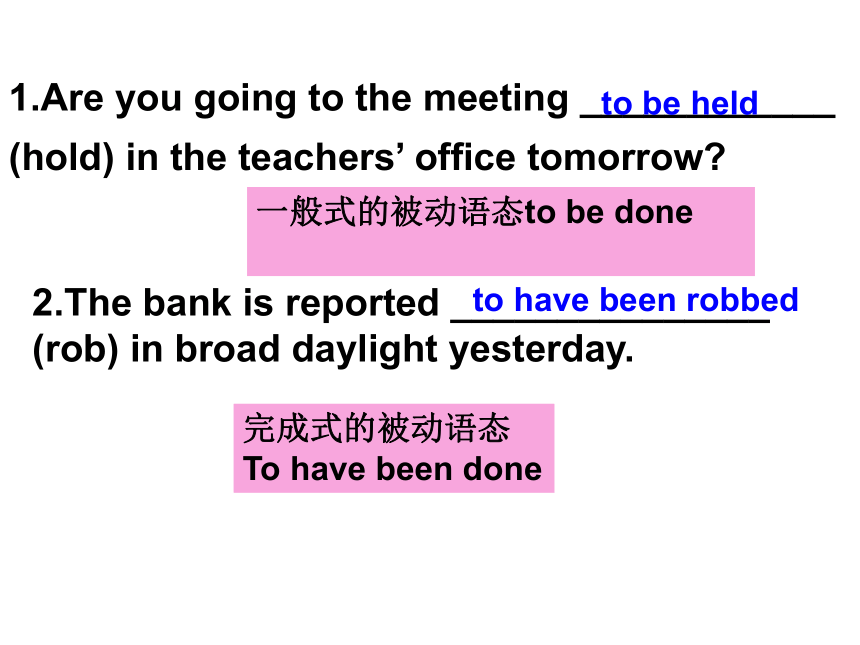

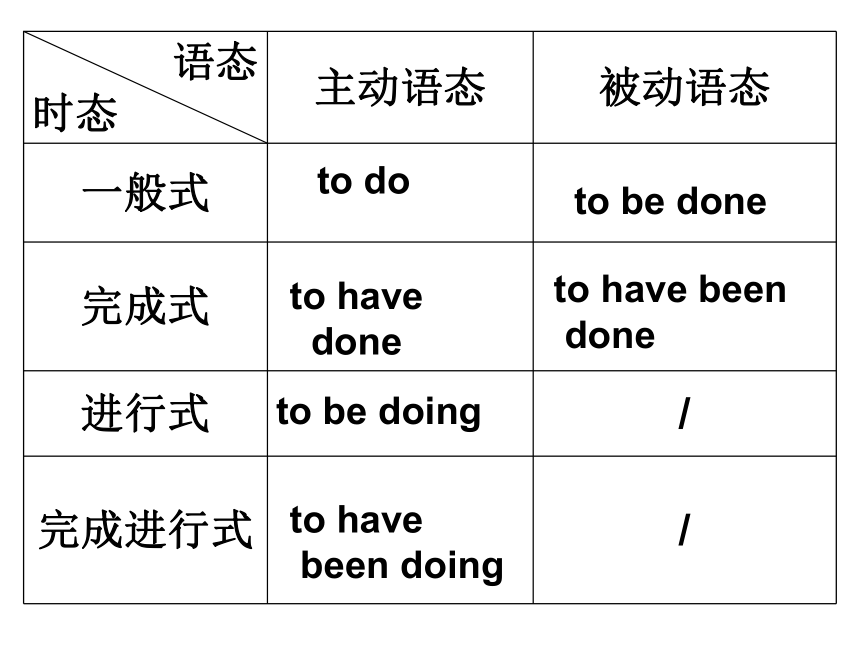


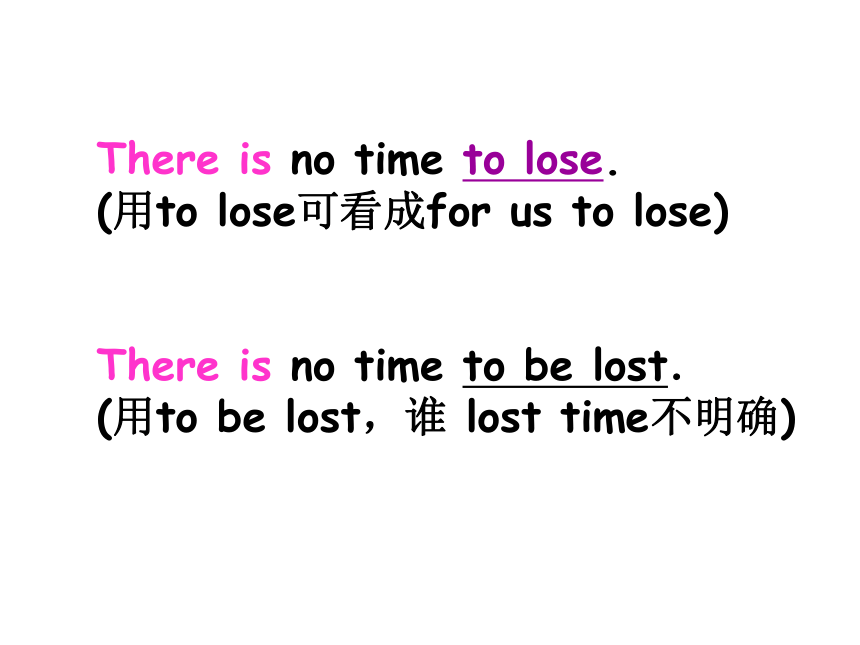

文档简介
课件22张PPT。 Revision of The passive InfinitiveHe hope _________(see) you again.
I’m sorry ______________(lose) your key.
It happened _____________(rain) when I got
there.
He appears ___________________(wait ) a
long time.to seeto have lostto be rainingto have been waiting一般式to do完成式
to have done进行式
to be doing完成进行式
to have
been doing表示动作是在谓语动
词所表示的动作之前就一直在进行。1.Are you going to the meeting ____________
(hold) in the teachers’ office tomorrow?to be held2.The bank is reported _______________
(rob) in broad daylight yesterday.to have been robbed一般式的被动语态to be done
完成式的被动语态
To have been done不定式被动式讲与练不定式语法? 不定式的时态和语态 不定式时态:即一般式、完成式、进行式和完成进行式。
语态:主动语态和被动语态,如下表所示。to do
to have
done
to be doingto have
been doingto be doneto have been
done1.It is an honor for me ____________(ask) to speak here.
2.He thought it an honor _____________
(invite) to the party.
3.The books are not allowed ___________ (take) out of the room.
4. The book is said________________ (translate) into many languages.to be askedto have been invitedto be takento have been translated三、不定式的主动形式表示被动1. 在there be结构中。
例如: There is a lot of homework to do.
(也可用to be done)There is no time to lose (to be lost).There is no time to lose.
(用to lose可看成for us to lose)
There is no time to be lost.
(用to be lost,谁 lost time不明确)2.在某些“形容词+不定式”做表语的结构中,句子的主语又是动词不定式的逻辑宾语时,这时常用不定式的主动形式表达被动意义。这些形容词有 nice, easy, fit, hard, difficult, important, impossible, pleasant, interesting等。
例如: The book is difficult to read.
The house is comfortable to live in.
He is hard to believe in.
3. 在“too…to do; enough…to…”结构中。如:
The problem is too difficult to work out .
The house is big enough to live in.4. 在“with+n+to do”结构中。
例如: With nothing to do, he lay in bed. With so many exercises to do, I can’t go to the cinema.5. 当不定式的逻辑主语在句中出现时。
例如: I have a letter to type today.
Do you have anything to say?(I是to type的逻辑主语) (you是to say的逻辑主语)1) Do you have anything to send?
你有什么东西要寄吗?
(不定式to send的动作执行者是you)
2) Do you have anything to be sent?
你有什么要(别人)寄的东西吗?
(不定式to be sent的动作执行者是已被省略的someone else)注意比较6. 当不定式隐含在for sb to do结构中时。
This is the best book to read .7. 一些作表语用的不定式的主动形式。
常见的这类动词有let(出租), rent,
hire, blame等。
The house is to let. I felt I was to blame.8. need /require/want + V.- ing 表示“需要被…”,表示被动意义。
我的车需要修理。
My car needs repairing(=need to be
repaired).
1. The dishes need 2. The mail needs Sentence makingwashsendto be washed. to be sent. 3. The singer refused4. The house isphotographsellto be photographed. to be sold. 5. The wall is expectedpaintto be painted. frighten6. The bird seemsto be frightened.9.通常在believe, suppose, say, report等动词构成的句子中可以进行主动语态到被动语态以及被动语态和动词不定式的转换.如:They say that Mike is sick in bed.It is said that Mike is sick in bed.Mike is said to be sick in bed.据说麦克卧床不起.People believe that he was killed.It is believed that he was killed.He is believed to have been killed.
大家相信他被杀了.People reported that he had been arrested.It was reported that he had been arrested.He was reported to have been arrested.
1、某些感官动词加形容词及少数其他的动
词用主动语态表示被动意义。
smell, taste, wash, write, prove, sell ,
The dish tastes delicious.
The theory proved right at last.
The book is so interesting that it sells well. 不可以变成被动语态:The book is so interesting that it sells well.
“sell”此处为不及物动词“销售起来、
有销路”的意思;作及物动词为“卖、
出售”)
This kind of cloth washes well.(耐洗)
I’m sorry ______________(lose) your key.
It happened _____________(rain) when I got
there.
He appears ___________________(wait ) a
long time.to seeto have lostto be rainingto have been waiting一般式to do完成式
to have done进行式
to be doing完成进行式
to have
been doing表示动作是在谓语动
词所表示的动作之前就一直在进行。1.Are you going to the meeting ____________
(hold) in the teachers’ office tomorrow?to be held2.The bank is reported _______________
(rob) in broad daylight yesterday.to have been robbed一般式的被动语态to be done
完成式的被动语态
To have been done不定式被动式讲与练不定式语法? 不定式的时态和语态 不定式时态:即一般式、完成式、进行式和完成进行式。
语态:主动语态和被动语态,如下表所示。to do
to have
done
to be doingto have
been doingto be doneto have been
done1.It is an honor for me ____________(ask) to speak here.
2.He thought it an honor _____________
(invite) to the party.
3.The books are not allowed ___________ (take) out of the room.
4. The book is said________________ (translate) into many languages.to be askedto have been invitedto be takento have been translated三、不定式的主动形式表示被动1. 在there be结构中。
例如: There is a lot of homework to do.
(也可用to be done)There is no time to lose (to be lost).There is no time to lose.
(用to lose可看成for us to lose)
There is no time to be lost.
(用to be lost,谁 lost time不明确)2.在某些“形容词+不定式”做表语的结构中,句子的主语又是动词不定式的逻辑宾语时,这时常用不定式的主动形式表达被动意义。这些形容词有 nice, easy, fit, hard, difficult, important, impossible, pleasant, interesting等。
例如: The book is difficult to read.
The house is comfortable to live in.
He is hard to believe in.
3. 在“too…to do; enough…to…”结构中。如:
The problem is too difficult to work out .
The house is big enough to live in.4. 在“with+n+to do”结构中。
例如: With nothing to do, he lay in bed. With so many exercises to do, I can’t go to the cinema.5. 当不定式的逻辑主语在句中出现时。
例如: I have a letter to type today.
Do you have anything to say?(I是to type的逻辑主语) (you是to say的逻辑主语)1) Do you have anything to send?
你有什么东西要寄吗?
(不定式to send的动作执行者是you)
2) Do you have anything to be sent?
你有什么要(别人)寄的东西吗?
(不定式to be sent的动作执行者是已被省略的someone else)注意比较6. 当不定式隐含在for sb to do结构中时。
This is the best book to read .7. 一些作表语用的不定式的主动形式。
常见的这类动词有let(出租), rent,
hire, blame等。
The house is to let. I felt I was to blame.8. need /require/want + V.- ing 表示“需要被…”,表示被动意义。
我的车需要修理。
My car needs repairing(=need to be
repaired).
1. The dishes need 2. The mail needs Sentence makingwashsendto be washed. to be sent. 3. The singer refused4. The house isphotographsellto be photographed. to be sold. 5. The wall is expectedpaintto be painted. frighten6. The bird seemsto be frightened.9.通常在believe, suppose, say, report等动词构成的句子中可以进行主动语态到被动语态以及被动语态和动词不定式的转换.如:They say that Mike is sick in bed.It is said that Mike is sick in bed.Mike is said to be sick in bed.据说麦克卧床不起.People believe that he was killed.It is believed that he was killed.He is believed to have been killed.
大家相信他被杀了.People reported that he had been arrested.It was reported that he had been arrested.He was reported to have been arrested.
1、某些感官动词加形容词及少数其他的动
词用主动语态表示被动意义。
smell, taste, wash, write, prove, sell ,
The dish tastes delicious.
The theory proved right at last.
The book is so interesting that it sells well. 不可以变成被动语态:The book is so interesting that it sells well.
“sell”此处为不及物动词“销售起来、
有销路”的意思;作及物动词为“卖、
出售”)
This kind of cloth washes well.(耐洗)
